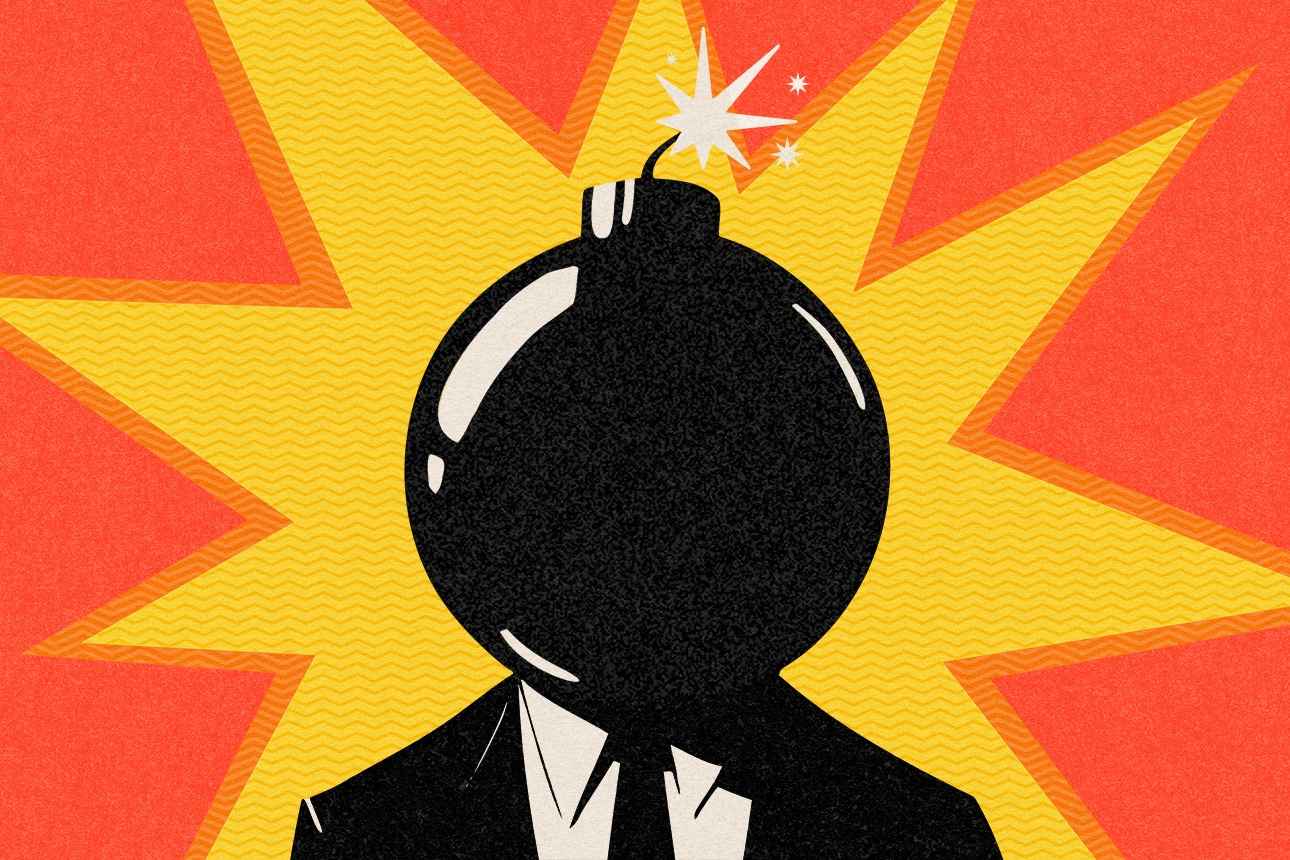Fight Versus Flight: When a Leader’s Fears Turn Into Anger
When a leader feels insecure, out of control, or threatened, they may fight back hard — and leave their team walking on eggshells. Here’s how to address the problem if you’re a fearful fighter or work with one.
News
- WhatsApp Must Seek Clear User Consent for All Data Uses, Antitrust Appeals Tribunal Clarifies
- NVIDIA’s Nemotron 3 Pushes Open Multi Agent AI Into The Mainstream
- ServiceNow in Talks to Acquire Cybersecurity Firm Armis for $7 Billion
- India Ranks 3rd in AI Competitiveness: Stanford Report
- Google Unveils Upgraded Gemini Deep Research Agent
- OpenAI Raises the Bar for Enterprise AI with GPT-5.2

You probably understand that the typical responses to fear are fight or flight. Two other options are freeze and fawn, which, like flight, are used by people trying to avoid or minimize a scary situation. In the context of leadership advice, we’ve tended to focus on the flight response — the tendency to withdraw meekly from tough or abusive situations and to suffer in silence. That emphasis is one reason why concepts like psychological safety are so widely discussed these days.
What I think we’ve ignored for far too long are the fight reactions to fear — where human fear also shows up as anger, disgust, contempt, and rejection. There is abundant data showing that these forms of aggressive behavior leave masses of employees afraid. Yet somehow, we’ve largely failed to consider that those angry behaviors — more often than not coming from people above us in the hierarchy — are also a sign of fear. For people in power, and men in particular, it simply may feel more acceptable to respond to fear with a fight response rather than a flight response. That’s the way we’ve been socialized, and it may even be a remnant of our evolution. It’s also highly damaging in modern organizations.
Recently, I asked a group of well-established working professionals to describe a situation where someone above them was, in their opinion, afraid — feeling insecure, threatened, or out of control — and, as a result, responded to that fear with an angry, fight response. Consider a few examples shared by managers, consultants, and analysts across a range of functions and companies (which we anonymized and paraphrased for industry and gender). See if these examples resonate with some painful, galling experiences of your own.
- When the project my team worked on was not looked on favorably by partners, my manager blamed all the support people. The manager gave me a horrible review and refused to change my marks because they wanted a scapegoat.
- My manager’s job was to bring in significant new business, but when that wasn’t happening they instead blamed me. My manager attacked my personal life and used things against me that I’d told them in confidence.
- We brought in a very large order last year, for which we were supposed to receive significant incentive compensation. My boss then gave us a much smaller bonus. When I talked to my boss, they got angry and said they could just take it all away, yelling and swearing at me the whole time.
- I prepared a presentation demonstrating how I was already performing at the next job level and meeting all expectations for a promotion. When I shared this with my direct manager, who was much older, they dismissed the idea and laughed at me, saying I was too young for a promotion like this. After this, they nitpicked my work and shut down conversations immediately in ways they’d never done before.
- Every time I’d ask my boss questions, they’d get passive, upset, or blow me off. Then I got told I was offending them by implying they weren’t good enough when I was trying to compliment them.
- My boss is a little intimidated by my education and previous employment. If I disagree with them on something, they go into “fight” mode — raising their voice.
- I requested the right to keep working from home more than one day a week. My boss lashed out, yelling, “I could make you come in all five days a week.”
I also asked the same group to tell me why they think their leader acted the way they did. Here’s what people from those examples said.
- They were afraid of seeming like an incompetent manager.
- They were getting pressure from above on lack of business, so instead of taking accountability for that and addressing the fear of losing their job, it was easier to point fingers at us.
- They were afraid of running over budget and the repercussions they’d get from their boss. Their angry/fight response occurs when they’re afraid of their own image.
- Their dismissive response and frustration and shift in demeanor when confronted with evidence of my readiness suggest they were threatened by the idea of someone younger advancing much more quickly than they had.
- They secretly feel inferior to our other senior manager, the person who technically leads the program.
- They are only placated when I say, “You’re right, boss,” as they want to know they’re safe and know what they’re doing. It validates that this is coming from their fear/insecurity.
- I realized this was about their own stress. They were stressed about being a caretaker [to a family member] and afraid they couldn’t navigate that because of the same work-in-office policies.
More generally, the explanations provided for the various forms of anger my respondents experienced reflected fears related to loss of control and, ultimately, failure. Ranging from immediate to enduring, these fear descriptions commonly included:
- Pressure from higher-ups to “deliver now, or else.”
- Imminent failure in achieving a goal.
- Exposure as being incompetent when unable to solve specific problems.
- A relative lack of performance, ability, needed skills, or knowledge that risks getting shown up by more capable others.
- An absolute inability to earn the trust, respect, or acceptance needed to succeed in a (new) role.
The Fight Response to Fear
Is this level of fear surprising in executives — people who’ve already achieved so much? Not in the least. High achievers are the most likely to have a huge part of their self-esteem tied up in looking competent and in control.1 And, more generally, as psychiatrist and author M. Scott Peck once said, “The absence of fear is some kind of brain damage,” because it’s the natural state of a human to recognize that bad things happen in life that we can’t prevent or control no matter our level or status.2
I’ve continually found the same thing in my research on workplace fear and courage: People at every level still have various professional, social, psychological, and even physical fears. A CEO doesn’t want to suffer the public embarrassment of being fired any more than the rest of us do. A vice president still worries that getting passed over for a new role due to a younger or junior hotshot outperforming them will lead to problems paying their mortgage and kids’ college costs.
More fundamentally, even people with significant organizational power have existential fears about the things that none of us can ever fully control or eliminate. Things like loved ones becoming seriously ill or dying, biological weapons or cyberterrorist attacks, nuclear and other kinds of war, a global economic meltdown, and climate change top lists of Americans’ fears.3 And in the era of news and social media being in our faces 24/7, it’s hard to escape the relentless reminders of these fears.
In this light, it’s not surprising that we so often see aggressive, angry responses to fear. It’s a natural, if unpleasant and damaging, way to try to reestablish what feels threatened: our sense of needing to be in control, of keeping ourselves and those we most care about safe, of looking and feeling competent.
People with little power or status can’t usually enact or get away with aggressive forms of fear and hence resort to fleeing, freezing, or fawning. But those with power have used anger to mask their fear and (try to) reassert control for the entirety of recorded history.4 How do they do so? By using dominance behaviors — their own displays of anger and power — to create fear and submission among the masses.
Here, in a nutshell, is what the process looks like.
The Anger Response to Fear
Why do leaders lash out? The fight response is often a reaction to fear — of perceived incompetence, for example, which would lead to a loss of control. The people at the top of a corporate team may wield anger as a tool when their power is threatened. The (unconscious) goal: Regain control by breeding fear that gets others to toe the line.
While the leader gains a fleeting sense of control, they also do lasting damage to their relationships with teammates, who lose trust in them. Having lost the team’s commitment, the leader will continue to face even more trigger events — and the cycle will continue.
For the fearful leader, the fight response to fear-invoking triggers appears to work in the short run: It helps the leader regain a sense of control. But it’s also highly self-defeating over time because it limits learning and leads to lots of other negatives among their teammates: the loss of trust, respect, commitment, and the willingness to be honest. And these negatives increase the likelihood that trigger events will keep happening, probably at an accelerating rate.5
Said one of my interviewees, “People started to walk on eggshells rather than bring their best ideas forward. [The leader’s] reactions … affected everyone’s willingness to engage, challenge ideas, or even ask for help.” Whether it happens consciously or not, the fight response to fear is ultimately self-defeating in many ways, unless dominating others until the bitter end is actually the objective.
“People started to walk on eggshells rather than bring their best ideas forward.”
Though few readers will likely feel good about what I’ve said so far, we also have to admit collective responsibility for this state of affairs. We tend to promote those who display (over)confidence, assertiveness, and even dominance, characterizing such qualities as signs of competence. On the flip side, calmer, more measured responses — including admissions of fear or other signs of “vulnerability” — may be labeled as weaknesses. Research shows that we’re more likely to tolerate — even reward — anger in men because it’s consistent with a stereotype of men as “agentic”; conversely, we’re more likely to denounce anger from women because it violates an expectation that they will be “warm” and “communal.”6 The converse is also true: A man who admits that he’s afraid and doesn’t charge forward assertively in every instance is more likely to be labeled as weak.7 Is it any wonder, then, that men often mask their fear with anger?
What Can We Do?
So, what can we do about people who respond to fear with variations of a fight response? This isn’t an easy problem to fix, because it’s often an unconscious move — or the person is disinterested in what it would take to change. And, conversely, people on the receiving end of fear-driven outbursts coming from higher-ups have to tread very carefully. Nonetheless, here are some practical suggestions.
If you might be a fearful fighter:
Start with an honest fear assessment. What keeps you up at night because it would be devastating if it were to happen? What pressures or expectations of others have you feeling stressed-out a lot? What goals or ambitions for yourself are you afraid of not reaching?
Get honest input on your behavioral responses. Seek feedback on how others perceive you at your worst. When are you being either passively or actively aggressive? When are your feelings of one type or toward one target leaking out in other ways toward other people? If you have any significant degree of power in the organization, you’ll need to ask the few people who aren’t automatically afraid to tell you the truth, or ask for anonymous feedback. This likely excludes most of your direct reports.
Take responsibility and make amends. Accept the idea that being seen as a competent or strong leader by most people includes admitting that you sometimes make mistakes and need others’ help. In fact, these behaviors are likely to increase people’s willingness to follow you voluntarily. The same is true for apologizing if a fear comes out as a fight response: This humanizes you and makes people more likely to approach you during the times you need them most.
Learn new responses to fear. Figuring out what triggers your undesirable responses and owning them won’t be enough if you keep repeating the same behaviors. So whether it involves working with an executive coach or therapist, or finding some other way to adopt new behaviors, you must reduce the triggers and internalize a new set of responses to your underlying fears. This can include changing the nature of your goals and commitments, learning to quickly recognize the physiological indicators of your fear and anger, or developing strategies for changing your thought patterns in emotion-laden moments. This work may also require you to surround yourself with different people — fewer scared sycophants and more people who are willing to call you out when you go into fight mode.
If you work with a fearful fighter:
Diagnose the source of their fear. Try to discern what the leader is worried about not achieving; this is probably best determined through observation and other indirect methods rather than directly asking. Are they facing specific pressure from above? Who might be triggering fears in the leader by displaying greater expertise or outshining them in an absolute or relative sense? In other words, look beyond the surface indicators of anger for the factors that trigger a fear response in the leader. If nothing else, this may help you depersonalize the behavior you’re experiencing.
Minimize the causes of their fear. If it’s in your control to do so, take actions that could reduce the underlying sense of threat that the leader is experiencing. This might, for example, involve complimenting them on their strengths as a leader, reframing team stressors as being “exciting challenges” rather than “major threats,” or reminding the leader that you’ve weathered similar storms together in the past. The key is to come off as sincere, caring, and understanding without them feeling that you’ve diagnosed them as weak and in need of your help. The latter will only increase the leader’s fear of failing or being seen as a failure.
Respond empathically. Though this can be very hard to do when you’re on the receiving end of fight behavior, try to respond as you would if you suspected that someone vulnerable was afraid of you. For example, if your child were acting out for reasons you knew reflected fear, you’d try to respond empathically rather than distance yourself from them. Whether dealing with your child or your leader, simply saying, “I understand how stressful this is” or “This seems like a really tough time right now,” or asking, “Is there something I can do to help?” is sometimes enough to reduce a fight response in a fearful person.
Protect yourself. If you already have evidence that it’s unsafe for you to engage with a fearful leader, using the above options does not make sense. If you’ve tried some of the approaches, for example, and encountered even greater hostility or retaliatory behavior, it’s likely time to protect yourself. Try to minimize contact to the extent that it’s possible, and do what you can to keep yourself from (again) becoming a target of that person’s fear-based aggression.
You might choose fawning behavior if that’s the only way to avoid their wrath. That’s not healthy for anyone in the long run, but sometimes it’s the best you can do to stay safe in the moment. And if the problem is ongoing, with no intervention from above appearing likely anytime soon, it may well be time to polish your resume and start looking for a safer place to work.




